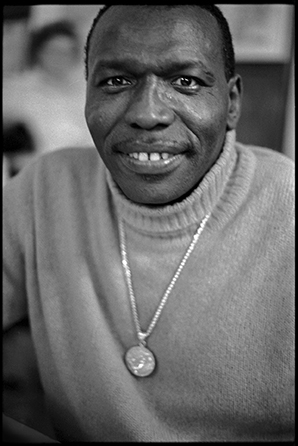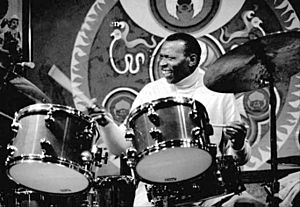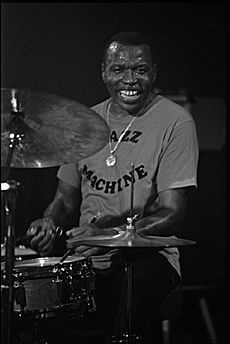Elvin Jones facts for kids
Quick facts for kids
Elvin Jones
|
|
|---|---|

Jones in 1979
|
|
| Background information | |
| Birth name | Elvin Ray Jones |
| Born | September 9, 1927 Pontiac, Michigan, U.S. |
| Died | May 18, 2004 (aged 76) Englewood, New Jersey, U.S. |
| Genres |
|
| Occupation(s) |
|
| Instruments |
|
| Years active | 1948–2004 |
| Associated acts |
|
Elvin Ray Jones (born September 9, 1927 – died May 18, 2004) was an amazing American jazz drummer. He was known for his powerful and unique drumming style. Elvin Jones played a big part in the post-bop era of jazz music.
He was most famous for being a member of the John Coltrane Quartet. He played with Coltrane from 1960 to 1965. During this time, they made many famous albums. These include My Favorite Things and A Love Supreme. After 1966, Elvin Jones started his own groups. He led his own trio and later larger bands called The Elvin Jones Jazz Machine.
Elvin had two brothers who were also famous jazz musicians. They were pianist Hank Jones and trumpeter Thad Jones. Elvin sometimes recorded music with them. In 1995, he was honored by being added to the Modern Drummer Hall of Fame. A jazz historian named Ted Gioia called Jones "one of the most influential drummers in the history of jazz." Rolling Stone Magazine also named him among the 100 Greatest Drummers of All Time.
Contents
Early Life and Musical Beginnings
Elvin Jones was born in Pontiac, Michigan. His parents, Henry and Olivia Jones, had moved there from Vicksburg, Mississippi. His older brothers, Hank and Thad, were already respected musicians. From a very young age, Elvin loved drums. He enjoyed watching circus parades pass by his home. The drummers in the marching bands especially excited him.
To follow his passion, Elvin joined his high school's black marching band. Here, he learned the basic drumming skills. Jones served in the United States Army from 1946 to 1949. After leaving the army, he used his pay to buy his first drum set. He also borrowed a little extra money from his sister.
Elvin Jones's Music Career
Early Years in Jazz (1949-1960)
Elvin Jones started his professional music career in 1949. His first job was at a club in Detroit. After that, he played with many different artists. These included Billy Mitchell and Wardell Gray. In 1955, he tried out for the Benny Goodman band but didn't get the spot.
He then moved to New York City and found work there. He played with famous musicians like Miles Davis and Charles Mingus. They recorded the album Blue Moods together. In the late 1950s, Jones was part of the Sonny Rollins trio. They recorded most of the album A Night at the Village Vanguard. This album is seen as a highlight for Rollins and for jazz music from the 1950s.
Playing with John Coltrane (1960–1966)
In 1960, Elvin Jones began playing with the legendary John Coltrane. By 1962, he became a key member of the classic John Coltrane Quartet. The other members were bassist Jimmy Garrison and pianist McCoy Tyner. Jones and Coltrane often played long duets together.
This band is known for changing the way "swing" felt in jazz. They updated the rhythmic feel, just like Louis Armstrong and Charlie Parker had done before them. Jones described playing with Coltrane as a wonderful experience. He said that no matter how far they traveled, their tiredness disappeared when they played. He felt it was as close to perfect harmony as people could get.
Jones continued to play with Coltrane until early 1966. By then, Coltrane was exploring new musical directions. Jones's drumming style, which used many different rhythms at once (called polyrhythmic), didn't fit as well with the group's new sound. Coltrane had also added a second drummer, Rashied Ali. Jones felt he couldn't contribute in the same way anymore, so he left the group.

Later Career and The Jazz Machine
After leaving Coltrane's group, Elvin Jones stayed very busy. He led several influential bands in the late 1960s and 1970s. One important group was a trio with saxophonist Joe Farrell and bassist Jimmy Garrison. They recorded albums like Puttin' It Together. Jones also made many recordings for the Blue Note label. These albums featured both famous and rising musicians.
His albums Live at the Lighthouse show the amazing talent of young saxophonists Steve Grossman and Dave Liebman. Jones also played on many "modal jazz" albums. These include The Real McCoy with McCoy Tyner and Speak No Evil with Wayne Shorter.
In the early 1980s, Jones formed his own group called the Elvin Jones Jazz Machine. The musicians in the group changed over the years. Ravi Coltrane, John Coltrane's son, played saxophone with the Jazz Machine in the early 1990s. They recorded the album In Europe in 1991. Jones's last recording as a band leader was The Truth: Heard Live at the Blue Note. It was recorded in 1999 and released in 2004. This album featured a larger version of his Jazz Machine.
Other musicians who played important roles in Jones's music during this time included Pepper Adams (baritone sax), George Coleman (tenor sax), Frank Foster (tenor sax), and Lee Morgan (trumpet). Jones also played drums for a musical Western film called Zachariah in 1971. In the movie, he played a drum solo after winning a gunfight.
Elvin Jones loved to teach. He often held workshops and played in schools. He even gave free concerts in prisons. His lessons covered music history and drumming techniques. In 2001, he received an honorary music degree from Berklee College of Music.
Death
Elvin Jones passed away from heart failure in Englewood, New Jersey, on May 18, 2004. He was survived by his wife, Keiko, and his children, Elvin Nathan Jones and Rose-Marie "Rosie" Jones.
Elvin Jones's Influence on Drummers
Elvin Jones's unique drumming style changed how people saw the drum set. His amazing sense of timing, use of polyrhythms (playing multiple rhythms at once), and control over how loud or soft he played (called dynamics) made his drumming stand out. He also used different sounds (called timbre) and smooth phrasing (called legato phrasing).
In 1970, Life Magazine called Jones "the world's greatest rhythm drummer." His free and flowing style greatly influenced many top drummers. These include Mitch Mitchell from the Jimi Hendrix Experience, Ginger Baker, Bill Bruford, John Densmore from The Doors, and Janet Weiss from Sleater-Kinney.
Images for kids
See also
 In Spanish: Elvin Jones para niños
In Spanish: Elvin Jones para niños



